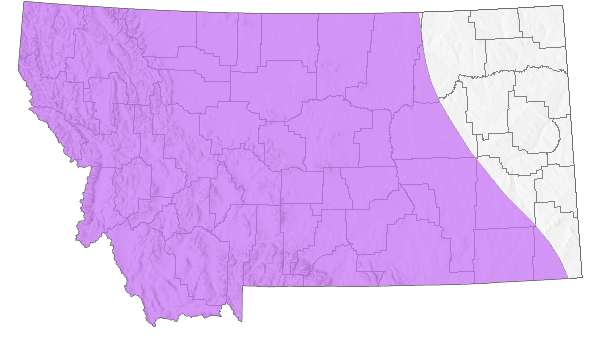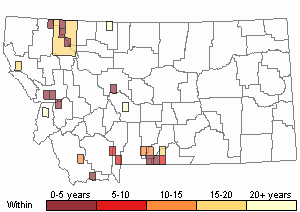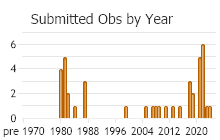View in other NatureServe Network Field Guides
NatureServe
Montana
Utah
Wyoming
Idaho
Wisconsin
British Columbia
South Carolina
Yukon
California
New York
Zerene Fritillary - Argynnis zerene
Native Species
Global Rank:
G5
State Rank:
S5
Agency Status
USFWS:
USFS:
BLM:
External Links
General Description
[From Ferris and Brown 1981; Scott 1986; Opler and Wright 1999; Glassberg 2001; Pyle 2002] Forewing 2.4-3.4 cm. Uppersurface of both wings deep orange to pale yellow with variable black markings, usually with very strong and wide forewing median spots, especially 2nd spot up from inner margin. Undersurface hindwing disk color ranging from purple to brown, postmedian white or silvered spots round to elongate and with outward brown extensions making a triangular shape, submarginal spots rounded with brown caps.
Phenology
One flight; mid-June to early September (Scott 1986). Mid-May to September (Glassberg 2001). Mid-June to mid-September (inland) and late July to late September (coastal) in Oregon (Warren 2005), early June to mid-September in Oregon and Washington (Pyle 2002), late may to September in British Columbia (Guppy and Shepard 2001).
Diagnostic Characteristics
Best determined by a combination of forewing median spots very strong and wide, especially 2nd spot up from inner margin; undersurface hindwing postmedian white or silvered spots round to elongate with outward brown extensions making a triangular shape, submarginal spots rounded with brown caps.
Species Range
Montana Range
Range Descriptions

 Native
Native
Range Comments
Southeastern Alaska and central British Columbia to southern Alberta and Saskatchewan, south to central California, Nevada, Utah, and New Mexico; post-Pleistocene pine forest relic populations in the Black Hills region of South Dakota and Nebraska (Johnson 1975; Scott 1986; Opler and Wright 1999; Glassberg 2001); to 2743 m elevation in Colorado (Brown 1957; Ferris and Brown 1981), coastal to 2743 m elevation in Oregon (Warren 2005). In Montana, reported throughout the western 4/5 of the state (Kohler 1980; Stanford and Opler 1993). Mainly common to abundant, some populations in California and Oregon rare to uncommon (Glassberg 2001).
Observations in Montana Natural Heritage Program Database
Number of Observations: 46
(Click on the following maps and charts to see full sized version)
Map Help and Descriptions
Relative Density

Recency



 (Observations spanning multiple months or years are excluded from time charts)
(Observations spanning multiple months or years are excluded from time charts)
Migration
Non-migratory; adults in some population disperse 2-3 km (McCorkle and Hammond 1988).
Habitat
Open montane conifer forests, montane meadows, forested roadsides, sagebrush steppe, salt-spray meadows, moist coastal dunes (Scott 1986; Opler and Wright 1999; Guppy and Shepard 2001; Glassberg 2001; Pyle 2002). In Glacier National Park, Montana reported from montane xeric meadows (Debinski 1993).
Food Habits
Larval food plants include several species of Viola (Hammond 1981; Scott 1986; Guppy and Shepard 2001; Pyle 2002; James and Nunnallee 2011). Adults feed on flower nectar (including Agastache, Arnica, Berteroa, Calyptridium, Cardamine, Ceanothus, Chrysothamnus, Cirsium, Erigeron, Eriogonum, Heterotheca, Medicago, Monardella, Monarda, Rudbeckia, Senecio, Taraxacum, Trifolium), dew, and dung (Garth and Tilden 1963; Ferris and Brown 1981; Pyle 2002; Scott 2014).
Reproductive Characteristics
Females lay eggs singly and haphazardly near host plant (Scott 1986; McCorkle and Hammond 1988). Eggs hatch in 13-19 days (depending on temperature), larvae build no nest, L1 instar overwinters among leaf debris on thin silk mat. Post-diapause L1 instar commences feeding in 5 days, L2 to L6 instar and pupation lasts 34-45 days, adults eclose (emerge from pupae) in 13-21 days, adults may live at least 21 days, adult females may undergo summer dry-season diapause in California (Scott 1979, 1986; Sims 1984; McCorkle and Hammond 1988; James 2008; James and Nunnallee 2011). Males patrol throughout the day in open areas in search of females (Scott 1975b, 1986).
Stewardship Responsibility
References
- Literature Cited AboveLegend:
 View Online Publication
View Online Publication Brown, F.M. 1957. Colorado Butterflies. Proceedings; Numbers Three through Seven. Denver Museum of Natural History, Denver, Co.
Brown, F.M. 1957. Colorado Butterflies. Proceedings; Numbers Three through Seven. Denver Museum of Natural History, Denver, Co. Debinski, D. 1993. Butterflies of Glacier National Park, Montana. Occasional Papers of the Museum of Natural History, the University of Kansas, Lawrence, Kansas. No. 159: 1-13.
Debinski, D. 1993. Butterflies of Glacier National Park, Montana. Occasional Papers of the Museum of Natural History, the University of Kansas, Lawrence, Kansas. No. 159: 1-13. Ferris, C.D. and F.M. Brown (eds). 1981. Butterflies of the Rocky Mountains. Univ. of Oklahoma Press. Norman. 442 pp.
Ferris, C.D. and F.M. Brown (eds). 1981. Butterflies of the Rocky Mountains. Univ. of Oklahoma Press. Norman. 442 pp. Garth, J.S. and J.W. Tilden. 1963. Yosemite butterflies: an ecological survey of the butterflies of the Yosemite sector of the Sierra Nevada, California. Journal of Research on the Lepidoptera 2: 1-96.
Garth, J.S. and J.W. Tilden. 1963. Yosemite butterflies: an ecological survey of the butterflies of the Yosemite sector of the Sierra Nevada, California. Journal of Research on the Lepidoptera 2: 1-96. Glassberg, J. 2001. Butterflies through Binoculars: A Field Guide to the Butterflies of Western North America. Oxford University Press.
Glassberg, J. 2001. Butterflies through Binoculars: A Field Guide to the Butterflies of Western North America. Oxford University Press. Guppy, C.S. and J.H. Shepard. 2001. Butterflies of British Columbia: including western Alberta, southern Yukon, the Alaska Panhandle, Washington, northern Oregon, northern Idaho, northwestern Montana. UBC Press (Vancouver, BC) and Royal British Columbia Museum (Victoria, BC). 414 pp.
Guppy, C.S. and J.H. Shepard. 2001. Butterflies of British Columbia: including western Alberta, southern Yukon, the Alaska Panhandle, Washington, northern Oregon, northern Idaho, northwestern Montana. UBC Press (Vancouver, BC) and Royal British Columbia Museum (Victoria, BC). 414 pp. Hammond, P.C. 1981. The colonization of violets and Speyeria butterflies on ash-pumice fields deposited by Cascadian volcanoes. Journal of Research on the Lepidoptera 20(3): 179-191.
Hammond, P.C. 1981. The colonization of violets and Speyeria butterflies on ash-pumice fields deposited by Cascadian volcanoes. Journal of Research on the Lepidoptera 20(3): 179-191. James, D.G. 2008. Comparative studies on the immature stages and developmental biology of five Argynnis spp. (subgenus Speyeria) from Washington. Journal of the Lepidopterists' Society 62(2): 61-70.
James, D.G. 2008. Comparative studies on the immature stages and developmental biology of five Argynnis spp. (subgenus Speyeria) from Washington. Journal of the Lepidopterists' Society 62(2): 61-70. James, D.G. and D. Nunnallee. 2011. Life histories of Cascadia butterflies. Corvallis, OR: Oregon State University Press. 447 p.
James, D.G. and D. Nunnallee. 2011. Life histories of Cascadia butterflies. Corvallis, OR: Oregon State University Press. 447 p. Johnson, K. 1975. Post-Pleistocene environments and montane butterfly relicts on the western Great Plains. Journal of Research on the Lepidoptera 14(4): 216-232.
Johnson, K. 1975. Post-Pleistocene environments and montane butterfly relicts on the western Great Plains. Journal of Research on the Lepidoptera 14(4): 216-232. Kohler, S. 1980. Checklist of Montana Butterflies (Rhopalocera). Journal of the Lepidopterists' Society 34(1): 1-19.
Kohler, S. 1980. Checklist of Montana Butterflies (Rhopalocera). Journal of the Lepidopterists' Society 34(1): 1-19. McCorkle, D.V. and P. C. Hammond. 1988. Bioogy of Speyeria zerene hippolyta (Nymphalidae) in a marine-modified environment. Journal of the Lepidopterists' Society 42(3): 184-195.
McCorkle, D.V. and P. C. Hammond. 1988. Bioogy of Speyeria zerene hippolyta (Nymphalidae) in a marine-modified environment. Journal of the Lepidopterists' Society 42(3): 184-195. Opler, P.A. and A.B. Wright. 1999. A field guide to western butterflies. Second edition. Peterson Field Guides. Houghton Mifflin Company, Boston, Massachusetts. 540 pp.
Opler, P.A. and A.B. Wright. 1999. A field guide to western butterflies. Second edition. Peterson Field Guides. Houghton Mifflin Company, Boston, Massachusetts. 540 pp. Opler, P.A., K. Lotts, and T. Naberhaus, coordinators. 2010. Butterflies and moths of North America. Big Sky Institute, Bozeman, MT. Available at: www.butterfliesandmoths.org (Accessed 15 June 2015).
Opler, P.A., K. Lotts, and T. Naberhaus, coordinators. 2010. Butterflies and moths of North America. Big Sky Institute, Bozeman, MT. Available at: www.butterfliesandmoths.org (Accessed 15 June 2015). Poole, R.W. and P. Gentili, and R.E. Lewis (eds.). 1996. Nomina Insecta Nearctica: a checklist of the insects of North America. Volume 3 (Diptera, Lepidoptera, Siphonaptera). Entomological Information Services, Rockville, MD.
Poole, R.W. and P. Gentili, and R.E. Lewis (eds.). 1996. Nomina Insecta Nearctica: a checklist of the insects of North America. Volume 3 (Diptera, Lepidoptera, Siphonaptera). Entomological Information Services, Rockville, MD. Pyle, R.M. 2002. The butterflies of Cascadia: a field guide to all the species of Washington, Oregon, and surrounding territories. Seattle Audubon Society, Seattle, Washington. 420 pp.
Pyle, R.M. 2002. The butterflies of Cascadia: a field guide to all the species of Washington, Oregon, and surrounding territories. Seattle Audubon Society, Seattle, Washington. 420 pp. Scott, J.A. 1975b. Mate-locating behavior of western North American butterflies. Journal of Research on the Lepidoptera 14:1-40.
Scott, J.A. 1975b. Mate-locating behavior of western North American butterflies. Journal of Research on the Lepidoptera 14:1-40. Scott, J.A. 1979. Hibernal diapause of North American Papilionoidea and Hesperioidea. Journal of Research on the Lepidoptera 18(3): 171-200.
Scott, J.A. 1979. Hibernal diapause of North American Papilionoidea and Hesperioidea. Journal of Research on the Lepidoptera 18(3): 171-200. Scott, J.A. 1986. The butterflies of North America: a natural history and field guide. Stanford University Press, Stanford, California.
Scott, J.A. 1986. The butterflies of North America: a natural history and field guide. Stanford University Press, Stanford, California. Scott, J.A. 2014. Lepidoptera of North America 13. Flower visitation by Colorado butterflies (40,615 records) with a review of the literature on pollination of Colorado plants and butterfly attraction (Lepidoptera: Hersperioidea and Papilionoidea). Contributions of the C.P. Gillette Museum of Arthopod Diversity. Fort Collins, CO: Colorado State University. 190 p.
Scott, J.A. 2014. Lepidoptera of North America 13. Flower visitation by Colorado butterflies (40,615 records) with a review of the literature on pollination of Colorado plants and butterfly attraction (Lepidoptera: Hersperioidea and Papilionoidea). Contributions of the C.P. Gillette Museum of Arthopod Diversity. Fort Collins, CO: Colorado State University. 190 p. Sims, S.R. 1984. Reproductive diapause in Speyeria (Lepidoptera: Nymphalidae). Journal of Research on the Lepidoptera. 23(3): 211-216.
Sims, S.R. 1984. Reproductive diapause in Speyeria (Lepidoptera: Nymphalidae). Journal of Research on the Lepidoptera. 23(3): 211-216. Stanford, R.E. and P.A. Opler. 1993. Atlas of western USA butterflies: including adjacent parts of Canada and Mexico. Unpubl. Report. Denver and Fort Collins, Colorado 275 pp.
Stanford, R.E. and P.A. Opler. 1993. Atlas of western USA butterflies: including adjacent parts of Canada and Mexico. Unpubl. Report. Denver and Fort Collins, Colorado 275 pp. Warren, A.D. 2005. Lepidoptera of North America 6: Butterflies of Oregon, their taxonomy, distribution, and biology. Contributions of the C. P. Gillette Museum of Arthropod Diversity, Colorado State University. Fort Collins, Colorado. 406 pp.
Warren, A.D. 2005. Lepidoptera of North America 6: Butterflies of Oregon, their taxonomy, distribution, and biology. Contributions of the C. P. Gillette Museum of Arthropod Diversity, Colorado State University. Fort Collins, Colorado. 406 pp.
- Additional ReferencesLegend:
 View Online Publication
View Online Publication
Do you know of a citation we're missing? Allen, T.J., J.P. Brock, and J. Glassberg. 2005. Caterpillars in the field and garden: a field guide to the butterfly caterpillars of North America. Oxford University Press.
Allen, T.J., J.P. Brock, and J. Glassberg. 2005. Caterpillars in the field and garden: a field guide to the butterfly caterpillars of North America. Oxford University Press. Brock, J.P. and K. Kaufman. 2003. Kaufman Field Guide to Butterflies of North America. Houghton Mifflin Company, New York, NY 284 pp.
Brock, J.P. and K. Kaufman. 2003. Kaufman Field Guide to Butterflies of North America. Houghton Mifflin Company, New York, NY 284 pp. Caruthers, J.C., and D. Debinski. 2006. Montane meadow butterfly species distributions in the Greater Yellowstone Ecosystem. University of Wyoming National Park Service Research Center Annual Report, 2006. Vol. 30, Art. 14. 85-96.
Caruthers, J.C., and D. Debinski. 2006. Montane meadow butterfly species distributions in the Greater Yellowstone Ecosystem. University of Wyoming National Park Service Research Center Annual Report, 2006. Vol. 30, Art. 14. 85-96. Debinski, D. M. 1991. Inventory and monitoring of biodiversity: an assessment of methods and a case study of Glacier National Park, MT. Ph.D. Dissertation. Montana State University, Bozeman. 205 p.
Debinski, D. M. 1991. Inventory and monitoring of biodiversity: an assessment of methods and a case study of Glacier National Park, MT. Ph.D. Dissertation. Montana State University, Bozeman. 205 p. Forister, M.L., C.A. Halsch, C.C. Nice, J.A. Fordyce, T.E. Dilts, J.C. Oliver, K.L. Prudic, A.M. Shapiro, J.K. Wilson, J. Glassberg. 2021. Fewer butterflies seen by community scientists across the warming and drying landscapes of the American West. Science 371:1042-1045.
Forister, M.L., C.A. Halsch, C.C. Nice, J.A. Fordyce, T.E. Dilts, J.C. Oliver, K.L. Prudic, A.M. Shapiro, J.K. Wilson, J. Glassberg. 2021. Fewer butterflies seen by community scientists across the warming and drying landscapes of the American West. Science 371:1042-1045. Forister, M.L., E.M. Grames, C.A. Halsch, K.J. Burls, C.F. Carroll, K.L. Bell, J.P. Jahner, et al. 2023. Assessing risk for butterflies in the context of climate change, demographic uncertainty, and heterogeneous data sources. Ecological Monographs 93(3):e1584. https://doi.org/10.1002/ecm.1584
Forister, M.L., E.M. Grames, C.A. Halsch, K.J. Burls, C.F. Carroll, K.L. Bell, J.P. Jahner, et al. 2023. Assessing risk for butterflies in the context of climate change, demographic uncertainty, and heterogeneous data sources. Ecological Monographs 93(3):e1584. https://doi.org/10.1002/ecm.1584 Fultz, J.E. 2005. Effects of shelterwood management on flower-visiting insects and their floral resources. M.Sc. Thesis. Bozeman, MT: Montana State University. 163 p.
Fultz, J.E. 2005. Effects of shelterwood management on flower-visiting insects and their floral resources. M.Sc. Thesis. Bozeman, MT: Montana State University. 163 p. Hendricks, P. and M. Roedel. 2001. A faunal survey of the Centennial Valley Sandhills, Beaverhead County, Montana. Report to the U.S. Bureau of Land Management and U.S. Fish and Wildlife Service. Montana Natural Heritage Program, Helena, MT. 44 p.
Hendricks, P. and M. Roedel. 2001. A faunal survey of the Centennial Valley Sandhills, Beaverhead County, Montana. Report to the U.S. Bureau of Land Management and U.S. Fish and Wildlife Service. Montana Natural Heritage Program, Helena, MT. 44 p. Layberry, R.A., P.W. Hall, and J.D. LaFontaine. 1998. The Butterflies of Canada. University of Toronto Press. 280 pp. + color plates.
Layberry, R.A., P.W. Hall, and J.D. LaFontaine. 1998. The Butterflies of Canada. University of Toronto Press. 280 pp. + color plates. Maxell, B.A. 2016. Northern Goshawk surveys on the Beartooth, Ashland, and Sioux Districts of the Custer-Gallatin National Forest: 2012-2014. Montana Natural Heritage Program. Helena, MT. 114pp.
Maxell, B.A. 2016. Northern Goshawk surveys on the Beartooth, Ashland, and Sioux Districts of the Custer-Gallatin National Forest: 2012-2014. Montana Natural Heritage Program. Helena, MT. 114pp.
- Web Search Engines for Articles on "Zerene Fritillary"
- Additional Sources of Information Related to "Insects"





